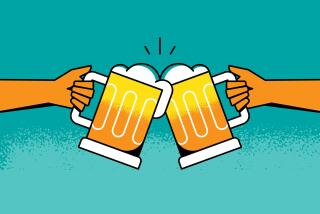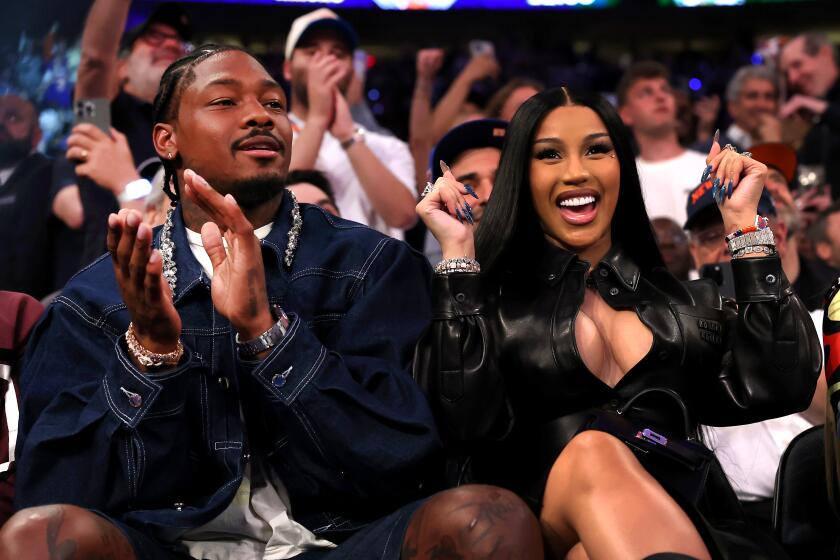Chili Peppers Taste Success at Last : After seven long years, L.A.’s loony punk-funk band finally gains respect for its music as well as its off-stage antics
- Share via
This was a big day for the Red Hot Chili Peppers, the loony, anarchic L.A. band that’s worshiped by some and scorned by many. Flea, the group’s bass player, was in lively spirits as he bounced into the back seat of the limousine in front of his apartment with the cheer of a goofy, hyperactive kid.
“This is great,” he said as the limo turned onto nearby Beverly Boulevard. “It’s a novelty to ride in one of these in my own neighborhood. Usually if we do it, it’s in New York or if a promoter gets us picked up at an airport or something. But to drive down Beverly is a novelty. I usually ride my bike down here.”
Flea’s enthusiasm last Saturday seemed to brighten the mood of his pal Anthony Kiedis, the Chili Peppers’ lead singer, who had been preoccupied with his right ankle. During a San Francisco show three days earlier, the athletic performer did a pole-vault with the mike stand and made a bad landing, tearing his ligaments.
The injury almost ruined the Chili Peppers’ big day, but after seven years of hard touring, 18 months after their guitarist’s death nearly ended the story, the Chili Peppers were at a pinnacle of sorts, and Kiedis was determined to give it his best shot.
“Mother’s Milk,” released last summer, has become the best-selling of the band’s four albums, at nearly 400,000. The group with the reputation for on-stage and off-stage mayhem, the brotherhood of Jimi Hendrix fanatics who like to undress during their shows, was being embraced by MTV and played on album-rock radio. And on the last weekend of their breakthrough year, they were headlining their biggest show yet, at the scaled-down, 6,000-capacity Long Beach Arena.
It might just mean that the Chili Peppers’ mixed signals are finally coming into focus. The band’s blend of punk aggression and funk music has drawn a devoted audience of high-energy, slam-dancing kids; the Peps’ preoccupation with sexual organs and activities has given them an “Animal House” reputation as gimmicky exhibitionists, and their overlooked but impressive playing has earned some respect from real music fans.
It’s added up to a ball of confusion.
“There’s a big misconception about us,” said Flea, wearing a beanie in the Lakers’ colors of purple and gold. “We have this image of being these nutty, crazy guys that wear socks on their (sex organs) and make funny faces and jump around. We are very intent on having a good time when we play our music. We’re entertainers, we’re funny, we like to make the audience laugh and make ourselves laugh.
“But we’re very dedicated to the music we play, we’ve put a lot of hard work and a lot of thought into it, to try not to sound like anybody else and to be ourselves as hard as we can. I think people are starting to realize that we play music and it’s real music and it’s new music.”
John Frusciante, a brash 19-year-old from Chatsworth, knows what the Chili Peppers mean to their audience, because he was a fan of the band before he was hired as its guitarist shortly after his predecessor, Hillel Slovak, died from a drug overdose.
“Their shows were very important to me,” Frusciante said earlier in the day when he dropped by Kiedis’ apartment. “They expressed a lot of the philosophies that I was feeling in my heart. . . . I think our music complements their lives. . . . All their feelings about sex, or their problems with racism or their problems with just never feeling outside of the rest of the world. I think our music gives those people a path and a feeling there’s still hope for the world, or at least hope as individuals.”
Kiedis, drinking coffee and packing for the trip to Long Beach, concurred.
“There’s millions of people growing up in this world that feel slightly alienated from the mainstream of life. They can’t really attach themselves to, say, Motley Crue or the Rolling Stones. They just don’t feel a part of that style of energy.
“They feel slightly outcast and kind of geeky or different from the rest of the world, and then they hear someone like the Red Hot Chili Peppers who basically represent ultimate honesty and freedom to be whatever it is you are and not be ashamed of it. . . . “
Frusciante placed his straw hat over his dyed-bright-red hair and left for the arena.
“It’s a good thing John came along when he did,” said Kiedis, who like Slovak used heroin and was shocked into going clean by his friend’s death.
“After Hillel died we had become slightly disillusioned. Flea and I knew we hadn’t accomplished what we set out to accomplish. We had lost sight of the importance and the beauty of what we had created. When John came along he kind of reminded us of the effect we have on people, so it was a shot of fresh, funky, young blood right in the face when we needed it.”
The Chili Peppers aren’t the tight-knit circle they were before Slovak died and drummer Jack Irons left in the aftermath, but they’re finding a new equilibrium. The two new members, Frusciante and drummer Chad Smith, live in the same square-mile area as Flea and Kiedis, and the band still treasures its ties to its hometown pavements.
“This is where we grew up,” said Kiedis, 27, looking out the limousine window at the Hollywood-bordering Fairfax area, “and we are affected by our surroundings. L.A., and Hollywood specifically, is a very huge element of what we’re all about. . . . This is an incredible place, and it shows in our music. It’s disgusting and it’s beautiful at the same time, which is basically what life is all about. We got a very concentrated dose of reality growing up in this town.”
Kiedis moved here from Michigan when he was 11 and spent his early teens in the unconventional household of his father, “a super freak, an over-the-edge playboy on the Sunset Strip,” according to Kiedis.
The environment was a formative element in the Chili Peppers’ sensibility. “I was able to see that there was beauty in the freak,” the long-haired singer said. “You didn’t have to be a conformist or get in line with the rest of the world to accomplish what you want to accomplish.”
But life with father also had its negative side, and Kiedis left home at 16 to become a punk-rock fan and a budding actor.
“I was really just kind of a wandering knucklehead, a wandering, slightly poetic knucklehead on the streets. When (rap group) Grandmaster Flash & the Furious Five came out, it dawned on me that I could be part of the musical existence through my poetry combined with basic hard-core funk. . . . I didn’t know anything about singing, but I knew that I had something to say, and I could write poetry that seemed to fit well with music, so we started it up.”
Kiedis’ partner was his Fairfax High School buddy Flea (ne Michael Balzary), a member of progressive new-wave band What Is This and later of punk mayhem-mongers Fear. They formed the Chili Peppers in early ‘83, and their friend Slovak soon joined. The band released its debut album the next year, and has been building its base through incessant roadwork ever since. Only now have their record sales started to match their live drawing power.
While the Chili Peppers are a quintessential ‘80s L.A. band and feel a solidarity with local stalwarts like Fishbone, Thelonious Monster, X, Jane’s Addiction and Firehose, they rarely get the respect accorded those colleagues.
“We’ve been ignored a lot,” said Flea, the green-haired stepson of jazz bassist Walter Urban Jr. and the bearer of a Jimi Hendrix tattoo on his left shoulder.
“Whenever The Times or anyone are talking about records from L.A. bands that matter, we’re never on it, we’re never mentioned. That’s fine, but the fact is that we’ve been incredibly influential. Bands are emulating our sound, our aesthetic and our attitude.”
The Long Beach Arena doors opened at 7 p.m. and the lobby filled up with as diverse an assortment of Southland rock fans as you’ll find in one place, from surfers in T-shirts and shorts to black-clad punk die-hards to frat rats to Valley kids to glittery metal rockers.
No one in the sold-out house was a more dedicated Chili Peppers fan than John Ratzlaff, 21, of Simi Valley. He’s seen the band 18 times, starting with its shows at the smallest L.A. clubs. He wore a brace on his knee, injured in a scuffle with security guards at the Chili Peppers’ recent show at the Ventura Theatre.
Ratzlaff wasn’t crazy about the idea of his favorite band playing an arena where there’s no room to slam dance, and you can’t get to the stage. It’s almost as if they’re rock stars or something.
“It’s not like the places where you see Anthony and Flea walking around and you can talk to them,” he said. “But that’s the way it goes. I’m not going to give up on them.”
What does he get from the Chili Peppers?
“Energy,” he said. “The live show is the only thing. I don’t care about the records that much. It’s so energetic, when you’re dancing in the pit. It’s a door to cut loose.”
And what does it mean to him when the band undresses on stage?
“It means they don’t give a (damn),” Ratzlaff said with a grin.
The Chili Peppers hit the stage and the crowd came alive, and anyone who’d seen Kiedis hobbling around on his cane that afternoon had to cringe every time he went high into the air, even if he did try to land on his good left ankle. The band cranked, the audience was up and in head-snapping motion to the Peppers’ brink-of-mayhem, heavy-bottom funk laced with psychedelic frenzy and between-the-eyes raps.
In the dressing room after the show, Kiedis sat on the floor leaning against a couch, a makeshift ice bag covering his ankle, which was throbbing and vibrating. Kiedis was also bleeding from a cut between the first two fingers, from an encounter with the mike stand, or a guitar, or the floor. He wasn’t sure.
But every time a visitor stopped by, Kiedis looked up and asked the ultimate Red Hot Chili Peppers question: “Did it rock?”
Only after gathering a positive consensus did he allow himself a small smile.
“It took a while to get warmed up,” he said, “and the injury was distracting, and we like it a little more intimate. . . . But I had fun.”
More to Read
The biggest entertainment stories
Get our big stories about Hollywood, film, television, music, arts, culture and more right in your inbox as soon as they publish.
You may occasionally receive promotional content from the Los Angeles Times.








